ESP RENAULT ESPACE 2012 J81 / 4.G Owner's Manual
[x] Cancel search | Manufacturer: RENAULT, Model Year: 2012, Model line: ESPACE, Model: RENAULT ESPACE 2012 J81 / 4.GPages: 267, PDF Size: 8.95 MB
Page 102 of 267
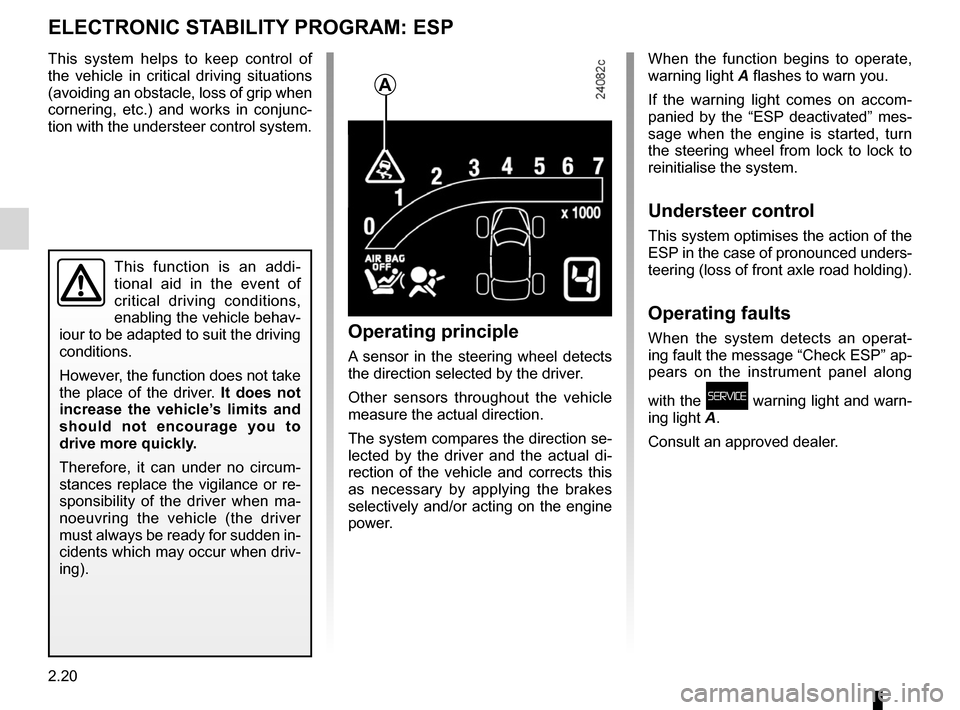
Electronic Stability Program: ESP ........ (up to the end of the DU)
ESP: Electronic Stability Program ........ (up to the end of the DU)
2.20
ENG_UD20371_1
Contrôle dynamique de conduite : E.S.P. avec contrôle de sous-virage (X81 - J81 - Renault)
ENG_NU_932-3_X81ph3_Renault_2
Electronic Stability Program: ESP
ELEcTRONIc STABILITY PROGRAM: ESP
This system helps to keep control of
the vehicle in critical driving situations
(avoiding an obstacle, loss of grip when
cornering, etc.) and works in conjunc -
tion with the understeer control system.
This function is an addi -
tional aid in the event of
critical driving conditions,
enabling the vehicle behav -
iour to be adapted to suit the driving
conditions.
However, the function does not take
the place of the driver. It does not
increase the vehicle’s limits and
should not encourage you to
drive more quickly.
Therefore, it can under no circum -
stances replace the vigilance or re-
sponsibility of the driver when ma -
noeuvring the vehicle (the driver
must always be ready for sudden in-
cidents which may occur when driv-
ing).
Operating principle
A sensor in the steering wheel detects
the direction selected by the driver.
Other sensors throughout the vehicle
measure the actual direction.
The system compares the direction se-
lected by the driver and the actual di -
rection of the vehicle and corrects this
as necessary by applying the brakes
selectively and/or acting on the engine
power. When the function begins to operate,
warning light
A flashes to warn you.
If the warning light comes on accom -
panied by the “ESP deactivated” mes -
sage when the engine is started, turn
the steering wheel from lock to lock to
reinitialise the system.
Understeer control
This system optimises the action of the
ESP in the case of pronounced unders-
teering (loss of front axle road holding).
Operating faults
When the system detects an operat -
ing fault the message “Check ESP” ap-
pears on the instrument panel along
with the
ú warning light and warn-
ing light A.
Consult an approved dealer.
A
Page 104 of 267
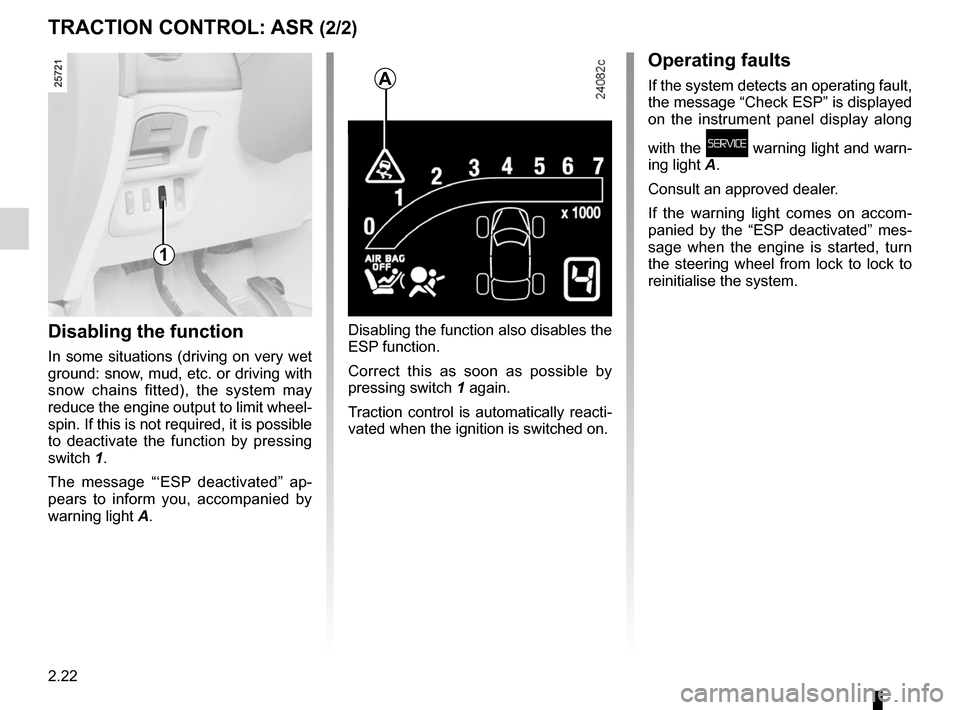
2.22
ENG_UD20372_1
Système antipatinage : A.S.R. (X81 - J81 - Renault)
ENG_NU_932-3_X81ph3_Renault_2
TRAcTION cONTROL: ASR (2/2)
Disabling the function
In some situations (driving on very wet
ground: snow, mud, etc. or driving with
snow chains fitted), the system may
reduce the engine output to limit wheel -
spin. If this is not required, it is possible
to deactivate the function by pressing
switch 1.
The message “‘ESP deactivated” ap -
pears to inform you, accompanied by
warning light A.
Disabling the function also disables the
ESP function.
Correct this as soon as possible by
pressing switch 1 again.
Traction control is automatically reacti-
vated when the ignition is switched on.
Operating faults
If the system detects an operating fault,
the message “Check ESP” is displayed
on the instrument panel display along
with the
ú warning light and warn-
ing light A.
Consult an approved dealer.
If the warning light comes on accom -
panied by the “ESP deactivated” mes -
sage when the engine is started, turn
the steering wheel from lock to lock to
reinitialise the system.
1
A
Page 111 of 267
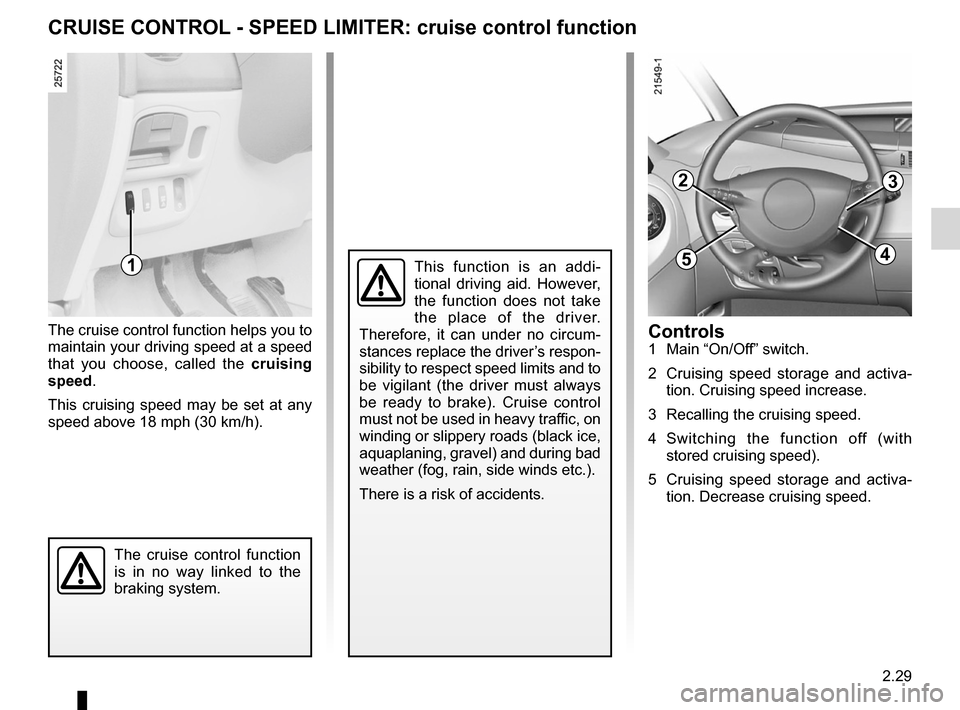
cruise control-speed limiter...................(up to the end of the DU)
cruise control ........................................ (up to the end of the DU)
driving ................................................... (up to the end of the DU)
2.29
ENG_UD1794_1
Régulateur-Limiteur de vitesse : fonction régulateur (X81 - Renau\
lt)
ENG_NU_932-3_X81ph3_Renault_2
Régulateur de vitesse
cRUISE cONTROL - SPEED LIMITER: cruise control function
The cruise control function helps you to
maintain your driving speed at a speed
that you choose, called the cruising
speed.
This cruising speed may be set at any
speed above 18 mph (30 km/h).controls1 Main “On/Off” switch.
2 Cruising speed storage and activa -
tion. Cruising speed increase.
3 Recalling the cruising speed.
4 Switching the function off (with
stored cruising speed).
5 Cruising speed storage and activa -
tion. Decrease cruising speed.
The cruise control function
is in no way linked to the
braking system.
This function is an addi -
tional driving aid. However,
the function does not take
the place of the driver.
Therefore, it can under no circum -
stances replace the driver’s respon -
sibility to respect speed limits and to
be vigilant (the driver must always
be ready to brake). Cruise control
must not be used in heavy traffic, on
winding or slippery roads (black ice,
aquaplaning, gravel) and during bad
weather (fog, rain, side winds etc.).
There is a risk of accidents.1
2
5
3
4
Page 115 of 267

parking distance control........................(up to the end of the DU)
driving ................................................... (up to the end of the DU)
2.33
ENG_UD20377_1
Aide au parking (X81 - J81 - Renault)
ENG_NU_932-3_X81ph3_Renault_2
Parking distance control
PARKING DISTANcE cONTROL
Operating faults
When the system detects an operating
fault there will be a 5-second, continu -
ous warning beep when reverse gear is
selected. Consult an approved dealer.
When the vehicle is being driven
at a speed below 7 mph (12 km/h),
certain noises (motorcycle, lorry,
pneumatic drill, etc.) may trigger the
beeping sound.
This function is an addi -
tional aid that indicates the
distance between the vehi -
cle and an obstacle whilst
reversing, using sound signals.
Under no circumstances should it
replace the driver’s care or respon-
sibility whilst reversing.
The driver should always pay atten-
tion to sudden incidents during driv-
ing: always ensure that there are no
moving obstacles (such as a child,
animal, pram, bicycle, etc.) or small,
narrow objects such as stones or
posts in your path when manoeu -
vring.
Operating principle
Ultrasonic detectors, installed in the
front or rear bumper depending on the
vehicle, measure the distance between
the vehicle and an obstacle whilst re -
versing.
This measurement is indicated by
beeps which become more frequent the
closer you come to the obstacle, until
they become a continuous beep when
the vehicle is approximately 32 centi -
metres from the obstacle.
Special features
Ensure that the ultrasonic sensors are
not obscured (by dirt, mud, snow, etc.).
Page 117 of 267
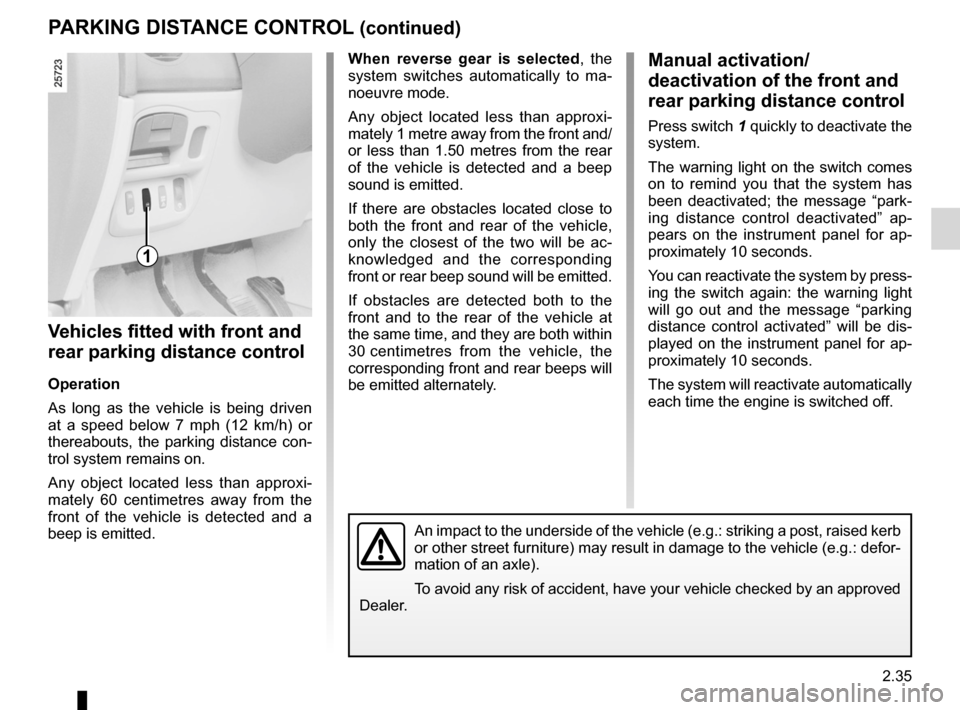
JauneNoirNoir texte
2.35
ENG_UD20377_1
Aide au parking (X81 - J81 - Renault)
ENG_NU_932-3_X81ph3_Renault_2
PARKING DISTANcE cONTROL (continued)
v ehicles fitted with front and
rear parking distance control
Operation
As long as the vehicle is being driven
at a speed below 7 mph (12 km/h) or
thereabouts, the parking distance con-
trol system remains on.
Any object located less than approxi -
mately 60 centimetres away from the
front of the vehicle is detected and a
beep is emitted. When reverse gear is selected
, the
system switches automatically to ma -
noeuvre mode.
Any object located less than approxi -
mately 1 metre away from the front and/
or less than 1.50 metres from the rear
of the vehicle is detected and a beep
sound is emitted.
If there are obstacles located close to
both the front and rear of the vehicle,
only the closest of the two will be ac -
knowledged and the corresponding
front or rear beep sound will be emitted.
If obstacles are detected both to the
front and to the rear of the vehicle at
the same time, and they are both within
30 centimetres from the vehicle, the
corresponding front and rear beeps will
be emitted alternately.
Manual activation/
deactivation of the front and
rear parking distance control
Press switch 1 quickly to deactivate the
system.
The warning light on the switch comes
on to remind you that the system has
been deactivated; the message “park -
ing distance control deactivated” ap -
pears on the instrument panel for ap -
proximately 10 seconds.
You can reactivate the system by press-
ing the switch again: the warning light
will go out and the message “parking
distance control activated” will be dis -
played on the instrument panel for ap-
proximately 10 seconds.
The system will reactivate automatically
each time the engine is switched off.
1
An impact to the underside of the vehicle (e.g.: striking a post, raised kerb
or other street furniture) may result in damage to the vehicle (e.g.: defor-
mation of an axle).
To avoid any risk of accident, have your vehicle checked by an approved
Dealer.
Page 120 of 267

2.38
ENG_UD24090_2
Boîte automatique (X81 - J81 - Renault)
ENG_NU_932-3_X81ph3_Renault_2
Jaune NoirNoir texte
AUTOMATIc GEARBOX (continued)
Driving in automatic mode
Select position D. In the majority of
traffic conditions, you will not have to
touch the gear selector lever again: the
gear will be changed automatically at
the right time and at the most suitable
engine speed because the automatic
system takes into account the vehicle
load and road contour and adjusts itself
to the particular driving style you have
chosen.
Economical driving
When driving, always leave the lever
in position D, keeping the accelerator
pedal lightly depressed to ensure auto-
matic gear changes at a lower engine
speed.
Accelerating and overtaking
Depress the accelerator pedal firmly
and fully (so that it goes beyond the
kickdown point).
This will enable you to change down
to the optimum gear within the
engine range.
Driving in manual mode
With the lever in position D, shift the
lever to the left-hand side.
Shifting lever 1 repeatedly allows you
to change gears manually:
– To move down through the gears,
push the lever backwards,
– To move up through the gears, push
the lever forwards.
The gear ratio engaged appears on the
instrument panel. Special cases
In certain driving conditions (e.g.:
engine protection, operation of the
electronic stability program: ESP), the
automated system may change the
gear automatically.
Likewise, to prevent incorrect manoeu
-
vres, a gear change may be refused by
the automatic system: in this case the
gear display flashes for a few seconds
as a warning.
Using an emergency spare wheel may
disrupt the operation of the automatic
gearbox.
1
Page 144 of 267
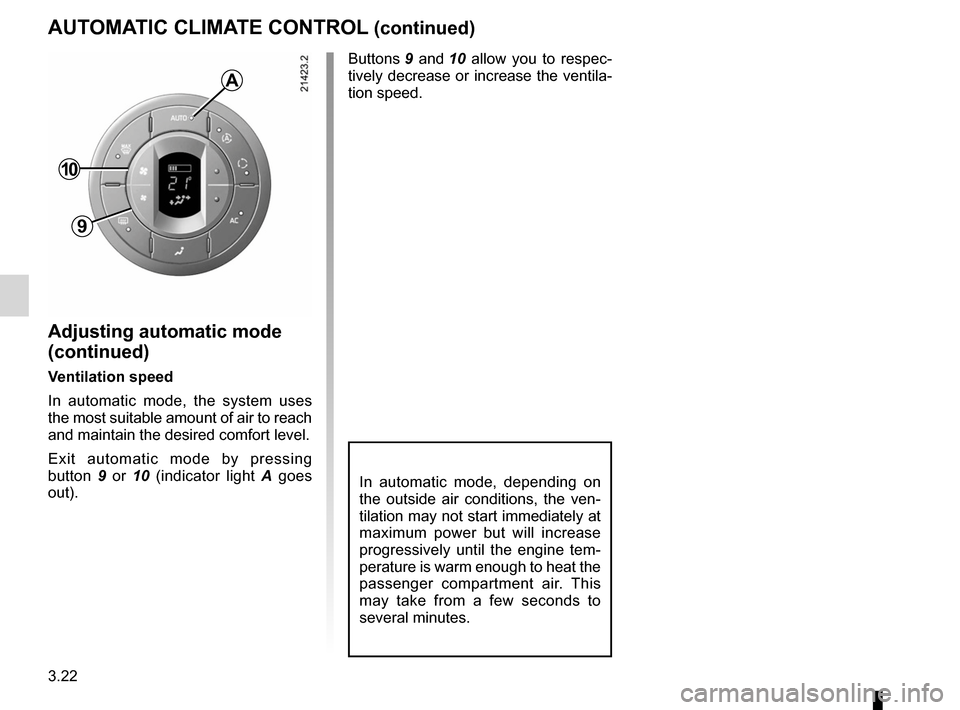
3.22
ENG_UD20382_1
Air conditionné automatique (X81 - J81 - Renault)
ENG_NU_932-3_X81ph3_Renault_3
Jaune NoirNoir texte
AUTOMATIC CLIMATE CONTROL (continued)
Adjusting automatic mode
(continued)
Ventilation speed
In automatic mode, the system uses
the most suitable amount of air to reach
and maintain the desired comfort level.
Exit automatic mode by pressing
button 9 or 10 (indicator light A goes
out).
Buttons 9 and 10 allow you to respec -
tively decrease or increase the ventila -
tion speed.
A
9
10
In automatic mode, depending on
the outside air conditions, the ven -
tilation may not start immediately at
maximum power but will increase
progressively until the engine tem -
perature is warm enough to heat the
passenger compartment air. This
may take from a few seconds to
several minutes.
Page 147 of 267
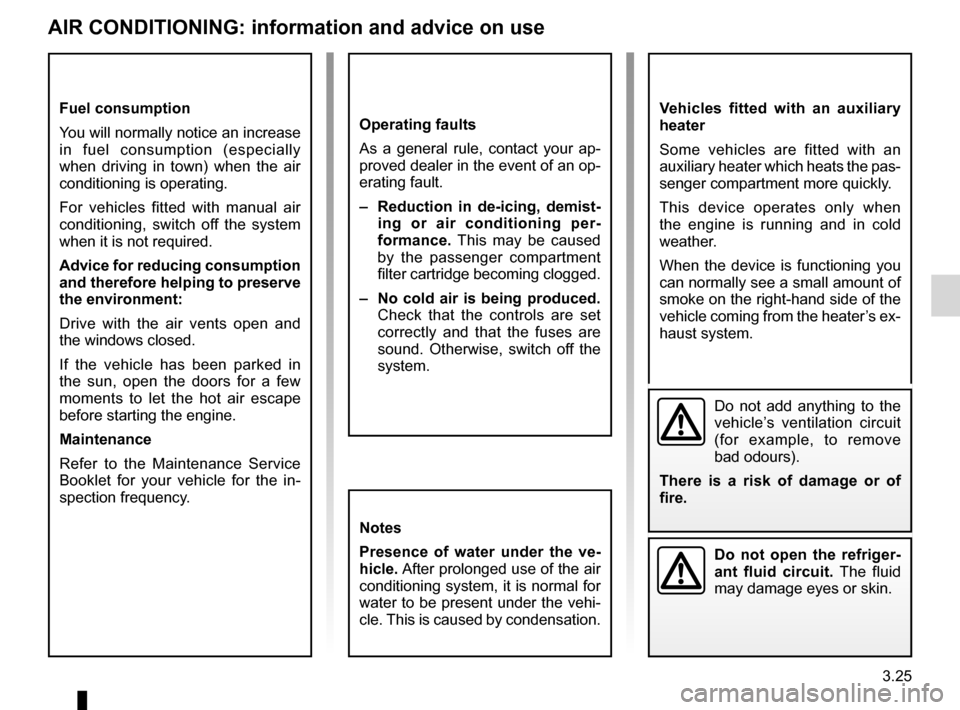
air conditioning ...................................................... (current page)
heating system ...................................................... (current page)
air conditioning ...................................................... (current page)
temperature regulation .......................................... (current page)
ventilation .............................................................. (current page)
heating and air conditioning system ...................... (current page)
3.25
ENG_UD11274_2
Air conditionné : informations et conseils d’utilisation (X81 - R\
enault)
ENG_NU_932-3_X81ph3_Renault_3
AIR CONDITIONING: information and advice on use
Fuel consumption
You will normally notice an increase
in fuel consumption (especially
when driving in town) when the air
conditioning is operating.
For vehicles fitted with manual air
conditioning, switch off the system
when it is not required.
Advice for reducing consumption
and therefore helping to preserve
the environment:
Drive with the air vents open and
the windows closed.
If the vehicle has been parked in
the sun, open the doors for a few
moments to let the hot air escape
before starting the engine.
Maintenance
Refer to the Maintenance Service
Booklet for your vehicle for the in -
spection frequency.Vehicles fitted with an auxiliary
heater
Some vehicles are fitted with an
auxiliary heater which heats the pas-
senger compartment more quickly.
This device operates only when
the engine is running and in cold
weather.
When the device is functioning you
can normally see a small amount of
smoke on the right-hand side of the
vehicle coming from the heater’s ex-
haust system.Operating faults
As a general rule, contact your ap-
proved dealer in the event of an op-
erating fault.
– Reduction in de-icing, demist -
ing or air conditioning per -
formance. This may be caused
by the passenger compartment
filter cartridge becoming clogged.
– No cold air is being produced.
Check that the controls are set
correctly and that the fuses are
sound. Otherwise, switch off the
system.
Do not open the refriger -
ant fluid circuit. The fluid
may damage eyes or skin.
Notes
Presence of water under the ve -
hicle. After prolonged use of the air
conditioning system, it is normal for
water to be present under the vehi-
cle. This is caused by condensation.
Do not add anything to the
vehicle’s ventilation circuit
(for example, to remove
bad odours).
There is a risk of damage or of
fire.
Page 148 of 267
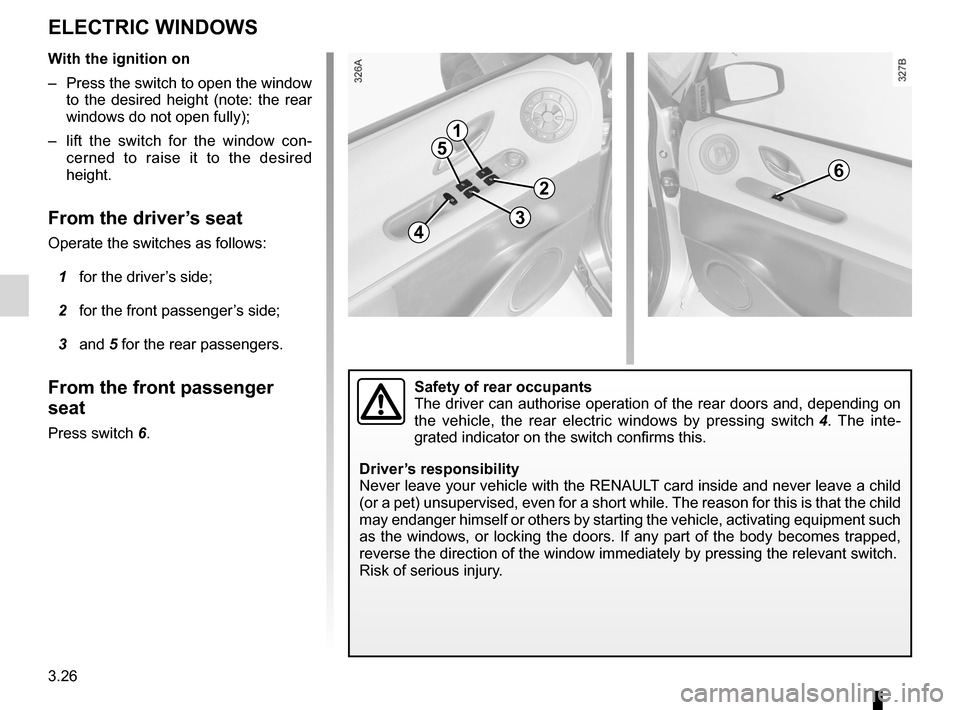
electric windows ................................... (up to the end of the DU)
3.26
ENG_UD11568_2
Lève-vitres électriques (X81 - Renault)
ENG_NU_932-3_X81ph3_Renault_3
Jaune NoirNoir texte
Electric windows
ELECTRIC WINDOWS
With the ignition on
– Press the switch to open the window
to the desired height (note: the rear
windows do not open fully);
– lift the switch for the window con -
cerned to raise it to the desired
height.
From the driver’s seat
Operate the switches as follows:
1 for the driver’s side;
2 for the front passenger’s side;
3 and 5 for the rear passengers.
From the front passenger
seat
Press switch 6.
1
5
43
2
6
Safety of rear occupants
The driver can authorise operation of the rear doors and, depending on
the vehicle, the rear electric windows by pressing switch 4 . The inte -
grated indicator on the switch confirms this.
Driver’s responsibility
Never leave your vehicle with the RENAULT card inside and never leave a child
(or a pet) unsupervised, even for a short while. The reason for this is that the child
may endanger himself or others by starting the vehicle, activating equipment such
as the windows, or locking the doors. If any part of the body becomes trapped,
reverse the direction of the window immediately by pressing the relevant\
switch.
Risk of serious injury.
Page 149 of 267

children .................................................................. (current page)
child safety ............................................................. (current page)
JauneNoirNoir texte
3.27
ENG_UD11568_2
Lève-vitres électriques (X81 - Renault)
ENG_NU_932-3_X81ph3_Renault_3
ELECTRIC WINDOWS (continued)
From the rear seats
Press switch 7.
Using switch 4
In the driver’s seat, switch 4 allows op-
eration of the rear windows, rear door
and rear heating and ventilation con -
trols to be inhibited (refer to the infor -
mation on “automatic climate control” in
Section 3).
7
15
4
3
2
Safety of rear occupants
The driver can authorise
operation of the rear doors
and, depending on the ve -
hicle, the rear electric windows by
pressing switch 4 . The integrated
indicator on the switch confirms this.
Driver’s responsibility
Never leave your vehicle with the
RENAULT card inside and never
leave a child (or a pet) unsuper -
vised, even for a short while. The
reason for this is that the child may
endanger himself or others by start-
ing the vehicle, activating equip -
ment such as the windows, or lock-
ing the doors. If any part of the body
becomes trapped, reverse the di -
rection of the window immediately
by pressing the relevant switch.
Risk of serious injury.